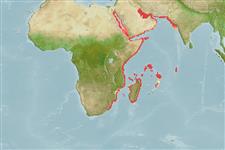Elasmobranchii (tubarões e raias) (sharks and rays) >
Torpediniformes (Electric rays) >
Torpedinidae (Electric rays)
Etymology: Torpedo: Latin, torpere = be sluggish (Ref. 45335).
Issue
Torpedo zugmayeri Engelhardt, 1912 could be a valid species after Weigmann (2016; Ref. 106604) (valid in ECoF, v. Jan. 2021).
Environment: milieu / climate zone / depth range / distribution range
Ecologia
marinhas; estuarina associadas(os) a recifes; intervalo de profundidade 1 - 200 m (Ref. 9710). Tropical; 30°N - 31°S, 30°E - 72°E (Ref. 114953)
Western Indian Ocean: Persian Gulf (Ref. 80050), Red Sea eastward to India (Ref. 2712) and southward to Natal, South Africa (Ref. 5578).
Tamanho / Peso / Idade
Maturity: Lm ? range ? - ? cm
Max length : 130 cm TL macho/indeterminado; (Ref. 2712)
Descrição suscinta
Chaves de identificação | Morfologia | Morfometria
Large ray with a small caudal fin and with papillae around the spiracles (Ref. 5578). Bright color pattern of circles and irregular marks, cream or golden on dark red or brown to blackish background dorsally (Ref. 5578).
Found inshore in sandy bottoms, and well offshore from the surf zone down to 200 m (Ref. 5578). Also on or near coral reefs (Ref. 12951, Ref. 114953). Common in shallow sandy areas (Ref. 2712). Feeds on bony fishes (Ref. 12951) and benthic invertebrates (Ref. 114953). Ovoviviparous (Ref. 50449). Males mature by 30 cm TL (Ref. 114953). Occurs singly but may form groups during the breeding season (Ref. 12951). Occasionally hooked by anglers, more often seen by divers; can deliver a strong shock (Ref. 2712). Flesh is edible (Ref. 12484). Can survive for hours after being stranded on the beach (Ref. 41394).
Exhibit ovoviparity (aplacental viviparity), with embryos feeding initially on yolk, then receiving additional nourishment from the mother by indirect absorption of uterine fluid enriched with mucus, fat or protein through specialised structures (Ref. 50449). With 9-22 in a litter (Ref. 12951). Form aggregations during the reproductive season (Ref. 41394).
Compagno, L.J.V., 1986. Torpedinidae. p. 112-113. In M.M. Smith and P.C. Heemstra (eds.) Smiths' sea fishes. Springer-Verlag, Berlin. (Ref. 2712)
Status na Lista Vermelha da UICN (Ref. 130435)
Uso pelos humanos
Peixe esportivo: sim
Ferramentas
Relatórios especiais
Baixar XML
Fontes da internet
Estimates based on models
Preferred temperature (Ref.
123201): 21.8 - 28.3, mean 25.5 °C (based on 370 cells).
Índice de diversidade filogenética (Ref.
82804): PD
50 = 0.5005 [Uniqueness, from 0.5 = low to 2.0 = high].
Bayesian length-weight: a=0.01585 (0.00973 - 0.02580), b=3.00 (2.86 - 3.14), in cm total length, based on LWR estimates for this species & (Sub)family-body (Ref.
93245).
Nível Trófico (Ref.
69278): 4.5 ±0.80 se; based on food items.
Resiliência (Ref.
120179): Muito baixo(a), tempo mínimo de duplicação da população maior que 14 anos (Fec=9-22).
Fishing Vulnerability (Ref.
59153): Very high vulnerability (78 of 100).
